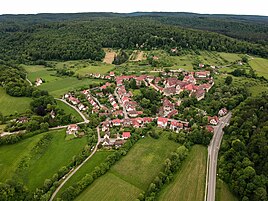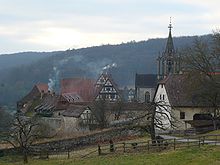Bebenhausen
|
Bebenhausen
University city of Tübingen
|
|
|---|---|
| Coordinates: 48 ° 33 '38 " N , 9 ° 3' 37" E | |
| Height : | 352 m |
| Area : | 13.37 km² |
| Residents : | 341 (Dec. 30, 2016) |
| Population density : | 26 inhabitants / km² |
| Incorporation : | 1st November 1974 |
| Postal code : | 72074 |
| Area code : | 07071 |
|
Location of Bebenhausen in Tübingen
|
|
|
Bebenhausen from the air (2018)
|
|

Bebenhausen is the smallest in terms of population and the largest in terms of area in the university town of Tübingen . The entire townscape is under ensemble protection . The local Cistercian monastery characterizes the place and is one of the most beautiful and best preserved medieval monastery complexes in Germany. In the 19th century and after the Second World War, the place and the former monastery for Württemberg-Hohenzollern gained political importance.
location
Bebenhausen is located three kilometers north of the city center of Tübingen on the L1208 state road on the edge of a wide basin at the confluence of the Goldersbach and Seebach rivers . Bebenhausen is the only place within the Schönbuch Nature Park . South of Bebenhausen, the Eberhard Karls University of Tübingen opened a geological educational trail on the Kirnberg in 1977 , on which the Keup layers are explained on several display boards and provide a good geological overview of the surrounding landscape.
The place has been a district of Tübingen since 1974 with around 350 inhabitants .
The monastery can be reached by public transport using the bus routes 754 Tübingen Hauptbahnhof - Bebenhausen, Waldhorn - Dettenhausen - Weil im Schönbuch - Holzgerlingen - Böblingen , the 826 Tübingen Hauptbahnhof - Bebenhausen, Waldhorn - Dettenhausen - Waldenbuch - Steinenbronn - Leinfelden and 828 Tübingen Hauptbahnhof - Bebenhausen , Waldhorn - Dettenhausen - Waldenbuch - Steinenbronn - Echterdingen - Stuttgart Airport . The buses run every hour.
History of the place
On November 1, 1974, Bebenhausen was incorporated into the district town of Tübingen.
History of the monastery
The Bebenhausen monastery was founded around 1183 by Count Palatine Rudolf von Tübingen as a family burial site, presumably an older castle, and settled with Premonstratensian canons. However, the Premonstratensians soon left the place.
Around 1189/90, Cistercians from the Schönau monastery were brought in to continue the founding of the monastery. They settled in the buildings begun by the Premonstratensians and quickly expanded the monastery. The strict rules of the order were violated, however, since the place was not in the necessary seclusion and Count Palatine Rudolf wanted to be buried in its foundation. Here, however, the monks from Schönau, who was the burial place of the Heidelberg Count Palatine , already had relevant experience.
At the end of the 13th century the convent already comprised over 60 monks, plus 130 conversations. Its economic power increased through numerous donations, so that in 1301 the city and castle of Tübingen could be bought and held for a short time. In the course of the 14th century the bailiwick came over the monastery to the empire, but with the sale of the rule of Tübingen by the Tübingen Count Palatine in 1342, sovereign rights over the monastery of Tübingen were transferred to Württemberg , which expanded these rights step by step and the old ones Imperial freedom finally abolished. Since 1498 the abbot had a seat in the Württemberg state parliament.
After the Reformation was introduced in 1535 by Duke Ulrich von Württemberg , the convent was expelled, but was able to return for a short time after the peace of the Augsburg religion. In 1556 Duke Christoph von Württemberg set up a Protestant monastery school in the monastery under the direction of a Protestant abbot. The Catholic convent finally left the monastery in 1560. The school moved to Tübingen in 1753. The monastery remained as an independent economic area until 1807, when the school and monastery administration were dissolved. The farm buildings were taken over by the Tübingen Forestry Office, and the convent buildings served as a royal hunting lodge. After his abdication as King Duke Wilhelm von Württemberg and his wife lived here.
From 1946 until the founding of the state of Baden-Württemberg in 1952, the state parliament of the state of Württemberg-Hohenzollern met in the Bebenhausen monastery .
History of the castle
King Friedrich dissolved the monastery school in 1806 and used Bebenhausen for royal court hunts. To do this, he had the former abbot house of the monastery converted into a hunting lodge. Under his successor Wilhelm I , Bebenhausen fell into disrepair, only the third Württemberg king, Karl used Bebenhausen again as a hunting lodge by having the former guest house of the monastery refurbished. His successor, Wilhelm II. Carried out further modifications and often stayed in Bebenhausen during the hunting season.
King Wilhelm II of Württemberg resigned his throne in Bebenhausen in 1918 and lived there until his death in 1921. His wife, Duchess Charlotte , also stayed in Bebenhausen until her death in 1946.
After renovation and restoration by the Reutlingen State Building Authority, the restored former royal representation and living quarters were reopened as a museum in 1986.
Personalities
- Eberhard Bidembach the Younger (1561–1591), Lutheran theologian
- Johann Valentin Andreae (1586–1654), theologian and from 1650 to 1654 abbot of the Protestant monastery school
- Karl Philipp Conz (1762–1827), poet and writer, student at the Protestant monastery school in Bebenhausen
- Karl Friedrich Kielmeyer (1765–1844), naturalist
- Friedrich Wilhelm Joseph Ritter von Schelling (1775-1854), philosopher, student of the Protestant monastery school in Bebenhausen
- Karl Eberhard Schelling (1783–1854), doctor and chief medical officer in Stuttgart, brother of Friedrich Wilhelm Joseph Schilling
- King Wilhelm II. (1848–1921) used the hunting lodge in the village and lived here after his abdication in 1918 until his death in 1921.
- Eugen Wilhelm Pfizenmayer (1869–1941), Württemberg-Russian palaeontologist and zoologist
- Hedwig Pfizenmayer (1890–1967), painter, lived there for several years
- Friedrich Sieburg (1893–1964), novelist, lived there from the end of the war until 1946
- August Heißmeyer (1897–1979), the former SS-Obergruppenführer and general of the Waffen-SS, went into hiding in Bebenhausen after the end of the Second World War, where he lived until his death.
- Gertrud Scholtz-Klink (1902–1999), “Reichsfrauenführer” in the National Socialist German Reich, wife of Heißmeyer's
- Kurt Georg Kiesinger (1904–1988), politician, spent his holidays and weekends in Bebenhausen
- Ernst Klink (1923–1993), historian
- Christiane Nüsslein-Volhard (* 1942), Nobel Prize winner, lives there
- Luise Walther , painter
Long-distance hiking trail
In addition, the Black Forest-Swabian Alb-Allgäu-Weg , also known as main hiking trail 5 , leads through Bebenhausen, a long-distance hiking trail of the Swabian Alb Association between Pforzheim and the West Allgäu .
Others
According to Baedeker, the Bebenhausen monastery settlement is "one of the most beautiful and best preserved of its kind in Germany".
Individual evidence
- ↑ Johannes Baier: The new geological nature trail in Kirnbachtal (Keuper, Schönbuch). In: Aufschluss 71, 2020, pp. 81–89.
- ^ Federal Statistical Office (ed.): Historical municipality directory for the Federal Republic of Germany. Name, border and key number changes in municipalities, counties and administrative districts from May 27, 1970 to December 31, 1982 . W. Kohlhammer, Stuttgart / Mainz 1983, ISBN 3-17-003263-1 , p. 539 .
- ↑ Actus oratorius atque valedictorius, 114 sheets, 20.5x17cm, Bebenhausen, 1753.
- ^ Nazi times on TÜpedia.
- ^ Baedeker editors: Germany 2000 ; 5th edition, Ostfildern (Karl Baedeker) 2000, p. 783, ISBN 3-89525-976-4 .
literature
- Nikola Hild, Katharina Hild: Bebenhausen. Monastery and castle. Silberburg-Verlag , Tübingen 2006, ISBN 3-87407-716-0 .
- Hans Haug: In the shadow of the monastery. The village of Bebenhausen. Silberburg-Verlag , Tübingen 2013, ISBN 978-3-8425-1265-8 .
- Mathias Köhler, Rainer Y, Carla Fandrey: Bebenhausen Monastery and Castle. Deutscher Kunstverlag , Munich a. a. 2005, ISBN 3-422-03113-8 ( State Palaces and Gardens Guide ).
Web links
- Bebenhausen Monastery and Castle near the State Palaces and Gardens of Baden-Württemberg
- Bebenhausen on www.tuebingen.de
- www.bebenhausen.de
- Presentation of cultural studies online (with numerous pictures)
- Prominent residents and visitors in Bebenhausen
- Murder stones and land monuments near Bebenhausen








